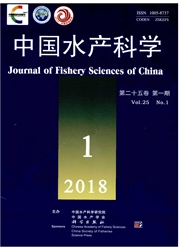

 中文摘要:
中文摘要:
将凡纳滨对虾(Litopenaeus vannamei)热休克蛋白70基因(heat shock protein 70,HSP70)克隆到原核表达载体pET-3c中,经酶切和DNA测序鉴定后,将重组质粒转入表达宿主BL21(DE3),在不同温度、时间下经IPTG诱导表达。收集菌液,进行SDS-PAGE和Western blot检测,并用软件Bandscan分析蛋白表达水平。结果表明,成功构建含凡纳滨对虾HSP70基因的重组表达载体pET-3c/HSP70,表达的目标蛋白相对分子量约为72kD,并能与小鼠抗人HSP70抗体特异性结合。37℃诱导5h目标蛋白表达量最高;但25℃诱导目标蛋白的可溶性比例达80%,目标蛋白占全菌总蛋白70%以上,均较37℃为高。
 英文摘要:
英文摘要:
For the aim to set up a high level prokaryotic expression of heat shock protein 70 (HSP70) of Litopenaeus vannrnei in E. coli BL21(DE3), the HSP70 gene of Litopenaeus vannmei was cloned into prokaryotic expression vector pET-3c, which subsequently, was determined by double-endonuclease digestion and DNA sequencing. The recombinant vector was transformed into E. coli BL21 (DE3) and was induced to express by 1 mmol/L IPTG. The quantity of the expression product, under different temperatures and durations, was evaluated with the software Bandsean. The quality of expression product was identified by SDS-PAGE and Western blot. The recombinant expression vector pET-3c/HSP70, expressing a 72 kD protein that could be recognized by mouse source HSP70 monoclonal antibody, was successfully constructed. The quantity of expression product varied according to different inducing temperature as well as inducing duration. The optimal condition for high level expression was induced at 37℃ for 5 h. But the optimal temperature for the favorable proportion of soluble target protein and the highest ratio of target protein to total amount protein of E. coli, which was up to 80 % and above 70 % respectively, was 25℃. This study provides a fundamental condition supporting researches on structure, function and biological activity of HSP70 of Litopenaeus vannmei.
 同期刊论文项目
同期刊论文项目
 同项目期刊论文
同项目期刊论文
 期刊信息
期刊信息
